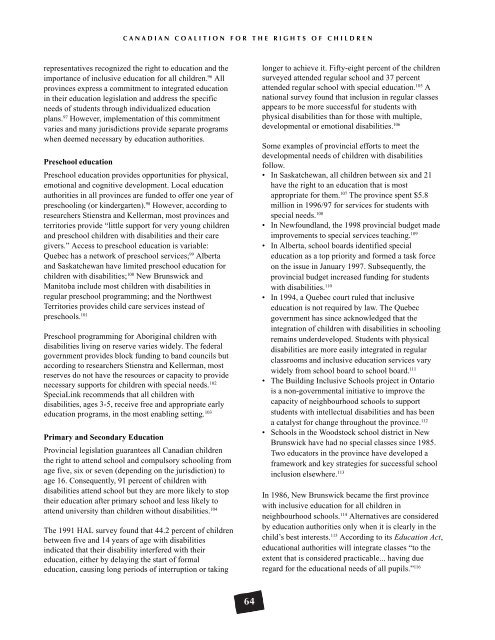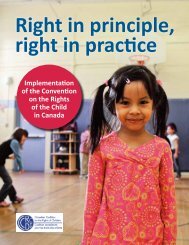Poste - Canadian Coalition for the Rights of Children
Poste - Canadian Coalition for the Rights of Children
Poste - Canadian Coalition for the Rights of Children
Create successful ePaper yourself
Turn your PDF publications into a flip-book with our unique Google optimized e-Paper software.
C A N A D I A N C O A L I T I O N F O R T H E R I G H T S O F C H I L D R E N<br />
representatives recognized <strong>the</strong> right to education and <strong>the</strong><br />
importance <strong>of</strong> inclusive education <strong>for</strong> all children. 96 All<br />
provinces express a commitment to integrated education<br />
in <strong>the</strong>ir education legislation and address <strong>the</strong> specific<br />
needs <strong>of</strong> students through individualized education<br />
plans. 97 However, implementation <strong>of</strong> this commitment<br />
varies and many jurisdictions provide separate programs<br />
when deemed necessary by education authorities.<br />
Preschool education<br />
Preschool education provides opportunities <strong>for</strong> physical,<br />
emotional and cognitive development. Local education<br />
authorities in all provinces are funded to <strong>of</strong>fer one year <strong>of</strong><br />
preschooling (or kindergarten). 98 However, according to<br />
researchers Stienstra and Kellerman, most provinces and<br />
territories provide “little support <strong>for</strong> very young children<br />
and preschool children with disabilities and <strong>the</strong>ir care<br />
givers.” Access to preschool education is variable:<br />
Quebec has a network <strong>of</strong> preschool services; 99 Alberta<br />
and Saskatchewan have limited preschool education <strong>for</strong><br />
children with disabilities; 100 New Brunswick and<br />
Manitoba include most children with disabilities in<br />
regular preschool programming; and <strong>the</strong> Northwest<br />
Territories provides child care services instead <strong>of</strong><br />
preschools. 101<br />
Preschool programming <strong>for</strong> Aboriginal children with<br />
disabilities living on reserve varies widely. The federal<br />
government provides block funding to band councils but<br />
according to researchers Stienstra and Kellerman, most<br />
reserves do not have <strong>the</strong> resources or capacity to provide<br />
necessary supports <strong>for</strong> children with special needs. 102<br />
SpeciaLink recommends that all children with<br />
disabilities, ages 3-5, receive free and appropriate early<br />
education programs, in <strong>the</strong> most enabling setting. 103<br />
Primary and Secondary Education<br />
Provincial legislation guarantees all <strong>Canadian</strong> children<br />
<strong>the</strong> right to attend school and compulsory schooling from<br />
age five, six or seven (depending on <strong>the</strong> jurisdiction) to<br />
age 16. Consequently, 91 percent <strong>of</strong> children with<br />
disabilities attend school but <strong>the</strong>y are more likely to stop<br />
<strong>the</strong>ir education after primary school and less likely to<br />
attend university than children without disabilities. 104<br />
The 1991 HAL survey found that 44.2 percent <strong>of</strong> children<br />
between five and 14 years <strong>of</strong> age with disabilities<br />
indicated that <strong>the</strong>ir disability interfered with <strong>the</strong>ir<br />
education, ei<strong>the</strong>r by delaying <strong>the</strong> start <strong>of</strong> <strong>for</strong>mal<br />
education, causing long periods <strong>of</strong> interruption or taking<br />
64<br />
longer to achieve it. Fifty-eight percent <strong>of</strong> <strong>the</strong> children<br />
surveyed attended regular school and 37 percent<br />
attended regular school with special education. 105 A<br />
national survey found that inclusion in regular classes<br />
appears to be more successful <strong>for</strong> students with<br />
physical disabilities than <strong>for</strong> those with multiple,<br />
developmental or emotional disabilities. 106<br />
Some examples <strong>of</strong> provincial ef<strong>for</strong>ts to meet <strong>the</strong><br />
developmental needs <strong>of</strong> children with disabilities<br />
follow.<br />
• In Saskatchewan, all children between six and 21<br />
have <strong>the</strong> right to an education that is most<br />
appropriate <strong>for</strong> <strong>the</strong>m. 107 The province spent $5.8<br />
million in 1996/97 <strong>for</strong> services <strong>for</strong> students with<br />
special needs. 108<br />
• In Newfoundland, <strong>the</strong> 1998 provincial budget made<br />
improvements to special services teaching. 109<br />
• In Alberta, school boards identified special<br />
education as a top priority and <strong>for</strong>med a task <strong>for</strong>ce<br />
on <strong>the</strong> issue in January 1997. Subsequently, <strong>the</strong><br />
provincial budget increased funding <strong>for</strong> students<br />
with disabilities. 110<br />
• In 1994, a Quebec court ruled that inclusive<br />
education is not required by law. The Quebec<br />
government has since acknowledged that <strong>the</strong><br />
integration <strong>of</strong> children with disabilities in schooling<br />
remains underdeveloped. Students with physical<br />
disabilities are more easily integrated in regular<br />
classrooms and inclusive education services vary<br />
widely from school board to school board. 111<br />
• The Building Inclusive Schools project in Ontario<br />
is a non-governmental initiative to improve <strong>the</strong><br />
capacity <strong>of</strong> neighbourhood schools to support<br />
students with intellectual disabilities and has been<br />
a catalyst <strong>for</strong> change throughout <strong>the</strong> province. 112<br />
• Schools in <strong>the</strong> Woodstock school district in New<br />
Brunswick have had no special classes since 1985.<br />
Two educators in <strong>the</strong> province have developed a<br />
framework and key strategies <strong>for</strong> successful school<br />
inclusion elsewhere. 113<br />
In 1986, New Brunswick became <strong>the</strong> first province<br />
with inclusive education <strong>for</strong> all children in<br />
neighbourhood schools. 114 Alternatives are considered<br />
by education authorities only when it is clearly in <strong>the</strong><br />
child’s best interests. 115 According to its Education Act,<br />
educational authorities will integrate classes “to <strong>the</strong><br />
extent that is considered practicable... having due<br />
regard <strong>for</strong> <strong>the</strong> educational needs <strong>of</strong> all pupils.” 116




